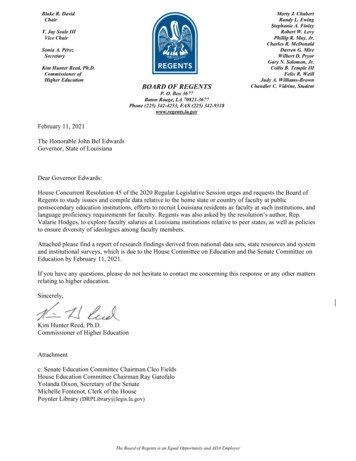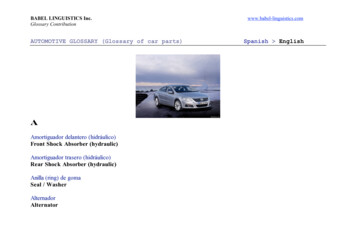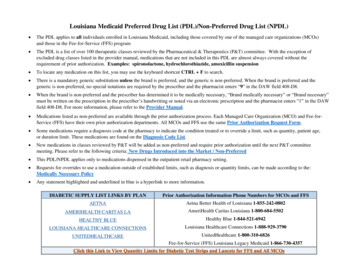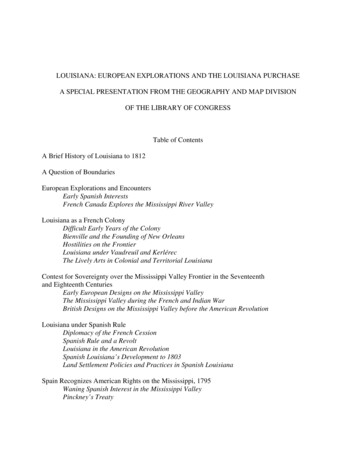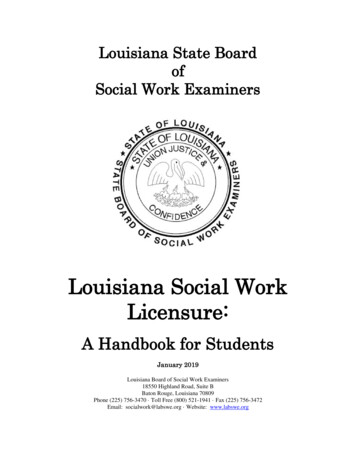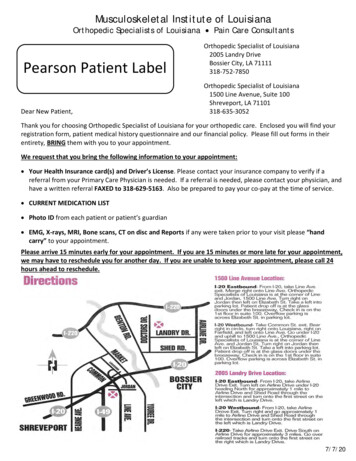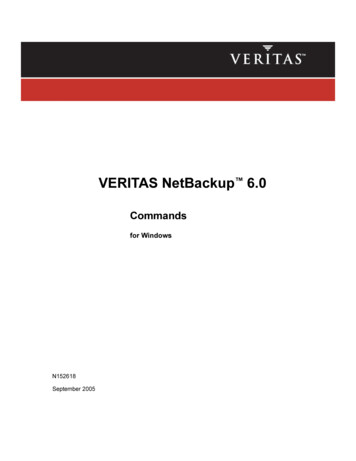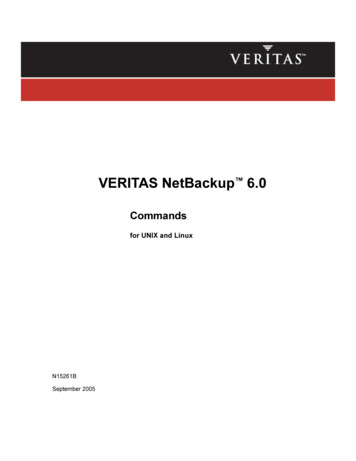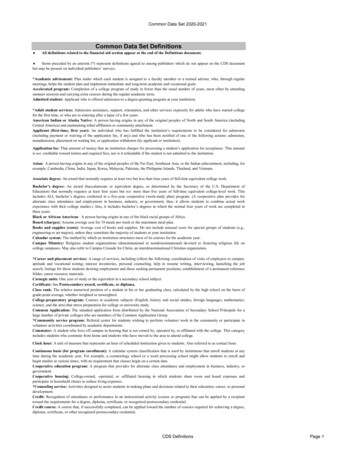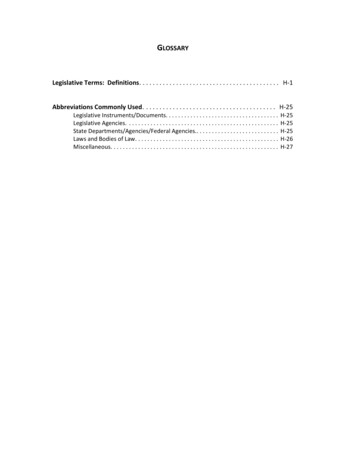
Transcription
GLOSSARYLegislative Terms: Definitions. . . . . . . . . . . . . . . . . . . . . . . . . . . . . . . . . . . . . . . . . . H-1Abbreviations Commonly Used. . . . . . . . . . . . . . . . . . . . . . . . . . . . . . . . . . . . . . . . H-25Legislative Instruments/Documents. . . . . . . . . . . . . . . . . . . . . . . . . . . . . . . . . . . . .Legislative Agencies. . . . . . . . . . . . . . . . . . . . . . . . . . . . . . . . . . . . . . . . . . . . . . . . . .State Departments/Agencies/Federal Agencies. . . . . . . . . . . . . . . . . . . . . . . . . . .Laws and Bodies of Law. . . . . . . . . . . . . . . . . . . . . . . . . . . . . . . . . . . . . . . . . . . . . . .Miscellaneous. . . . . . . . . . . . . . . . . . . . . . . . . . . . . . . . . . . . . . . . . . . . . . . . . . . . . . .H-25H-25H-25H-26H-27
GLOSSARYLegislative Terms: DefinitionsThis dictionary of legislative terms provides very brief explanations of the listed terms. Manyof the terms are formal parliamentary usage. Others are informal terms, and even slang terms,in common usage in the Louisiana Legislature. The cited provisions of the constitution, laws,and rules, where applicable, may be consulted for additional information.8G MoneyFunds appropriated annually by the legislature to the State Board ofElementary and Secondary Education and the Board of Regents in equalamounts from the Louisiana Quality Education Support Fund, aconstitutionally and statutorily established special fund in the statetreasury. This funding is referred to as "8(g) money" due to a federallaw reference to a settlement of disputed mineral production fundsfrom the Outer Continental Shelf. (Const. Art. VII, §10.1 and R.S.17:3801-3804)AbstractA concise overview of the contents of a bill appearing after the body ofthe bill and before the digest.ActA bill that has been finally passed by the House and Senate, enrolled,signed by the legislative presiding officers, signed by the governor (orallowed to become law without his signature), and assigned an actnumber by the secretary of state. Joint resolutions (proposedconstitutional amendments) are processed as bills, except they are notsigned by the governor or subject to the governor’s veto.Actuarial NoteAn estimate of the actuarial effect of a bill or resolution that will affecta state, parochial, or municipal retirement system. (R.S. 24:513(D)(2)and 521, Joint Rule 4(G), and House Rules 7.16(C), 7.17, and 14.48)AdjournmentTermination of business for a legislative day until a fixed hour on asucceeding day during a session. (Const. Art. III, §10(C) and House Rules9.6, 9.7, and 9.14A)AdjournmentSine DieFinal adjournment at the end of a legislative session. Sine Die (correctlypronounced "see-nay dee-ay"; in Louisiana, it is sometimes pronounced"sigh-knee die") is Latin for "without a day."AdoptTo finally approve an amendment, motion, or resolution.Glossary H-1
Agenda,CommitteeA list of instruments or other matters to be considered or acted uponat an upcoming committee meeting. (House Rule 14.30) (Also seeNotice, Committee)AG OpinionAn Attorney General's (AG) Opinion is a formal, written analysis of aquestion of law prepared by the attorney general at the request of thelegislature, head of an executive agency, or a state or local governingauthority or official.AmendmentThe modification of a bill or resolution by adding or deleting languageor changing wording. (House Rules 8.12, 8.13, 11.1 through 11.6)Committee amendment – Changes in a bill or resolution recommendedto the full house by a majority of the quorum present of the committeeto which the bill or resolution was referred. Must be adopted by the fullhouse to become a part of a bill or resolution. (House Rules 6.11, 6.12,14.6, and 14.7) (Also see Substitute Bill)Floor amendment – Amendment offered by a member of the house toa bill or resolution under consideration, usually when a bill is beingconsidered on the floor on third reading and final passage. (HouseRules 7.17, 7.19, and 9.13, 11.1 through 11.6)AmendmentRoomSmall room adjacent to the House Desk where staff are available todraft floor amendments to legislation while the House is in session.AppropriationBillA bill to authorize payment of funds from the state treasury to aparticular public entity; sometimes specifies a particular purpose.(Const. Art. III, §16 and Art. VII, §10(D), House Rules 6.6(C), 7.19, and11.6)General Appropriation Bill – Comprehensive bill to fund the ordinaryexpenses of the executive branch of state government. Appropriationsare itemized to show the public entity to which the appropriation ismade and the treasury fund from which it is made. The bill is organizedin “schedules” applicable to particular departments and agencies orfunctions, with “items” within each schedule. (Const. Art. III, §16, HouseRules 6.25, 7.3, 7.9(C) and (D), 7.19, 8.15, and 11.6)Appropriations for the legislative and judicial branches are proposedin separate bills.Capital Outlay Bill – Also an appropriation bill; it authorizesexpenditures for the capital construction needs of the state. (Const.H-2 Glossary
Art. VII, §6, House Rules 6.8(C) and 7.3)At EaseAn informal intermission in the House proceedings declared by theSpeaker, who may announce that "The House will stand at ease."AuthorThe member sponsoring a particular piece of legislation. (Also see Coauthor)BA-7(Budget Adjustment No. 7, as described in R.S. 39:73) A request for abudget adjustment or supplement, received from state agencies,reviewed by the Legislative Fiscal Office, and approved/rejected by theJoint Legislative Committee on the Budget.Bagneris RuleA Senate rules suspension to defer action on one or more bills. Thisshortcut motion is used exclusively by the Senate. This motion wasoriginated by former Senator Dennis Bagneris.BillA legislative instrument proposed by a legislator(s) to change existing orenact new statutory law or to repeal existing law, or to propose changesor additions to the constitution (joint resolutions). Statutory lawincludes the Louisiana Revised Statutes, various codes, and uncodifiedacts. (Const. Art. III, §15)Prefiled bill – Original bill that is filed by a legislator with the chiefclerical officer of the respective house prior to a legislative session.Such a bill receives a bill number, is printed, and may be assigned to andheard by a standing committee prior to a session. On the opening dayof the session, it will be formally introduced. (Const. Art. III, §2 andHouse Rules 6.11, 7.2, 14.16, 14.19, and 14.24)Original bill – The bill as introduced into the legislature that is used inthe legislative process until it is engrossed. (House Rules 7.2 and 7.6)Engrossed bill – Original bill prepared with amendments adopted uponinitial consideration by the house of origin incorporated into its text.Usually, this is a bill which incorporates committee amendments to theoriginal bill adopted during the second reading in the originating house.(Rarely, a bill is amended on the floor at second reading; and theengrossed bill, including these amendments, is referred to committee.)The engrossed bill is ordinarily the version used on the House floor fordebate on third reading and final passage. (House Rules 7.8, 7.9, 8.16,and 8.17)Reengrossed bill – Refers to a bill to which has incorporated in itGlossary H-3
additional amendments adopted in the house of origin after itsengrossment. Usually these are floor amendments adopted in thehouse of origin when the bill is considered on third reading and finalpassage, but could also refer to committee amendments from a secondcommittee adopted in the house of origin. (House Rules 7.8, 7.9, and7.10)Substitute bill – (See Substitute Bill)Enrolled bill – A bill in its final form, including all amendments agreedupon by both houses, to be submitted (joint resolutions excepted) tothe governor for approval or veto. (House Rules 7.12, 7.14, and 7.15)Bill NumberNumber given to each bill by the House Clerk or Senate Secretary'sOffice when it is first introduced or prefiled for a session. These billsreceive the same number for each session: the General AppropriationBill is House Bill No. 1, Capital Outlay Bill is House Bill No. 2, andOmnibus Bond Bill is House Bill No. 3. (House Rule 7.3)Bill RoomA central location during session which provides copies of bills andlegislative documents. The Bill Room is located on the Ground Floor onthe Senate side of the Capitol.Bill StatusThe current stage of a legislative instrument in its progression from itsintroduction to passage.BoilerplateStandard bill-drafting language used in the Louisiana Legislature anddesigned to maintain legal consistency and uniformity.Bruneau BoxAlso referred to as "cost box". A printed statement, bordered by a box,on a public document printed by a state agency that includes the nameand address of the agency that published it, at what cost, how manycopies, and for whom. This legislation was originated by former Rep.Emile "Peppi" Bruneau. (R.S. 43:31)BudgetStabilization FundCommonly known as "the rainy day fund," which is established as aspecial fund within the state treasury to be available for use in the statebudget in the event of certain unexpected shortfalls in revenue. Limitedto amounts necessary to cover a projected deficit or drop in revenues,also limited to certain amounts of the fund balance, and requires atwo-thirds vote of the legislature to appropriate from the fund. (Const.Art. VII, §10.3 and R.S. 39: 94 and 95)H-4 Glossary
Bust the CapThe legislature by a 2/3 vote may agree to increase the annualexpenditure limit ("the cap") of state general funds and dedicated fundsas provided for in the Constitution. An AG opinion stated that thelegislature may entertain changing the expenditure limit in any fiscalyear. (La. Atty. Gen. Op. # 07-0124) (Const. Art. VII, §10)CSGThe Council of State Governments. A multibranch organizationforecasting policy trends for the community of states, commonwealths,and territories on a national and regional basis. Serves the executive,judicial, and legislative branches of state government throughleadership education, research, and information services.Calendar(1) The daily listing in the Order of the Day, in order of precedence, ofresolutions, bills, and other documents on which action may be taken.(Also see Order of the Day)Debate calendar – The list of legislative instruments to beconsidered on third reading and final passage on a particular day.Subject to call – An instrument may be returned to the calendarupon approval of a majority of the members present and voting.Instruments so returned are listed in numerical order and may becalled from the calendar for further action or consideration at alater time when the House is in that same order of business. Onlythe author or the member handling a Senate instrument or amember authorized by such member may move to call aninstrument from the calendar. However, members must give atleast a day’s notice that they intend to call a bill from this calendar;and such bills are listed on the Order of the Day in the order theClerk received the member's notice under the heading "NoticeGiven Subject to Call". (House Rule 8.20) (Also see Order of theDay)Involuntary calendar – A Senate procedure when a legislativeinstrument is returned to calendar, subject to call, upon the orderof the majority of members present and voting. After such action,the instrument may be called from the calendar only upon afavorable vote of a majority of members present and voting.(2) The Legislative Calendar is the final published compilation of theaction on each instrument during a legislative session. It lists allinstruments in numerical order by house with a chronological notationof all action taken by each house. It includes an author, subject, andjournal information index. Interim Calendars are prepared periodicallyduring the interim. (House Rules 12.6 and 12.7)Glossary H-5
(3) The Interim Calendar is a compilation of the action taken on eachlegislative instrument prior to the convening of the legislative session.(House Rule 12.7)Calendar DayAny day from convening to adjournment of a legislative session whetheror not either house meets.CallThe proclamation by which the governor or the legislature convenes thelegislature into extraordinary session. The subject scope of the sessionis determined in this written document. (Const. Art. III, §2(B))Call the Bill orAmendmentThe announcement by the House Clerk or Senate Secretary of the itemabout to be debated on the floor.CaucusA group of legislators, most often organized on the basis of partyaffiliation, common interest, or regional representation. Also, a meetingof such a group. Some groups refer to themselves as “delegation”rather than caucus.Chamber(1) The rooms where the House and Senate meet. (2) The House orSenate itself. (For House chamber see House Rules 1.1 and 1.2)Claim Against theStateA financial judgment rendered by a court to pay a claim made by acitizen upon the state; requires appropriation in order to pay it. (Const.Art. XII, §10)ClerkThe clerical officer of the House of Representatives, elected by themembers. (Const. Art. III, §7 and House Rules 2.9 and 2.10)ClosingRefers to ending the debate on a bill, which only the author of a HouseBill or the handler of a Senate Bill has the right to do. Closing is limitedto 15 minutes. (House Rule 5.7)CoauthorLegislator who adds his/her name to the list of authors on anotherlegislator's bill, resolution, or amendment. (Joint Rule 12)CommendationResolution of either or both houses expressing legislative tribute. Alsomay be an interim commendation by an individual House member.CommitteeA group of legislators of one or both houses which considers legislation,conducts studies, and/or makes recommendations to the Senate and/orHouse.H-6 Glossary
Committee of the whole (COW) – The entire membership of the House,acting in the capacity of a committee to consider the GeneralAppropriation Bill or other matters. A member other than the Speakerserves as the chairman. (House Rules 6.18 through 6.25)Conference committee – A committee, composed of three membersfrom each house, the purpose of which is to propose to the two housesa means to resolve differences in a bill when the house of origin refusesto concur in amendments adopted by the opposite house. (House Rules6.14, 7.11, and 8.21)Interim committee – A special committee created to make a study orinvestigation during the interim between sessions of the legislature.(Joint Rule No. 13 and House Rules 6.8(B), 14.16, and 14.17)Joint committee – A committee composed of members of both houses.May be composed of standing committee members from each house (orcertain members thereof) or may be a special joint committee withmembers selected without regard to standing committee membership.Used during the interim. (House Rules 14.16, 14.17, and 14.49 and JointRules Nos. 8 and 13)Select committee – A committee established by the presiding officer ofa house composed of members of that house for a designated purpose.Special committee – A committee of one or both houses appointed fora limited purpose and discharged upon completion of this function.Standing committee – A permanent committee of the House or Senatewith subject matter jurisdiction defined by rules of its house. Functionsboth during and between legislative sessions to conduct public hearingson proposed legislation, review proposed administrative rules, make itsown studies of problems, make reports and recommendations to thehouse it serves, etc. (House Rules 6.1, 6.2, 6.3, 6.4, 6.5, 6.6, and Chapter14. Also Joint Rules Nos. 13 and 16)CommitteeReportA written list of the legislative instruments on which a standingcommittee took action and the committee's recommendation on each,including any proposed amendments. Includes certain other proceduralinformation. May also refer to the annual report of a standingcommittee's activities and studies during the interim. (House Rules 6.11and 14.45)Glossary H-7
Committee StaffThe staff assigned to assist a standing committee chair and members.This usually consists of the committee secretary, a legislative analyst,and/or an attorney.ConcurAction by the house of origin on a legislative instrument to agree toamendments to the instrument adopted by the opposite house.CondolenceA resolution which tenders condolences upon the death of a person.ConfereesMembers of a conference committee appointed by the House Speakeror Senate President.ConferenceCommitteeReportThe recommendations of a conference committee to resolve thedifferences between the two houses when the house of origin does notconcur in amendments adopted in the second house. (House Rules6.14, 7.11, and 8.27)Conflict ofInterestA situation in which any interest (financial or otherwise), any businessor professional activity, or any general activity may prevent the fairexecution of one's obligation of official duties. (Also see Recuse)ConstituentA citizen residing within a legislator’s district.ConstitutionThe written instrument stating the fundamental principles of a stategovernment. Unlike the federal constitution, a state constitution’sprovisions are not grants of power, but, instead, are limitations on theotherwise plenary power of the people of a state, exercised through itslegislature.ConstitutionalAmendment(See Joint Resolution under Resolution)ConveneThe assembling of a legislative body. Usually refers to the initialconvening of a legislative session.Co-Sponsor(See Coauthor)Custom, Usage,and PracticeLegislative procedures that, while not formally adopted or codified,have been sanctioned by general usage and have grown into generalacceptance. They are a source for parliamentary procedure in theHouse when the House Rules are silent or inexplicit. (House Rule 13.3)Cutoff DateTime certain set by a legislative body for specified action, such as billintroduction, committee action, or passage of bills by either house.H-8 Glossary
DeadThis means a bill is defeated or otherwise removed from considerationfor the rest of a session.DeferredA legislative instrument scheduled for hearing by a committee may bevoluntarily deferred upon the request of the author. An instrumentvoluntarily deferred without objection may be rescheduled forcommittee hearing. A legislative instrument is involuntarily deferredwhen so ordered by a vote of a majority of the committee memberspresent and voting, notwithstanding the request of the author. Aninvoluntarily deferred instrument may be rescheduled for a committeehearing (after opportunity for hearing all other House instrumentsrequested to be heard) only by motion adopted by the vote of twothirds of the committee members present and voting. (House Rules 6.9and 6.10)Desk, The orHouse DeskRaised area at the front of the House Chamber where the Clerk carriesout administrative functions, including the receipt of bills and proposedfloor amendments. The presiding officer presides from a raised deskbehind the House Desk. (House Rule 1.2, Diagram)DigestA summary of the substance of a legislative instrument that appears atthe end of the text of the instrument. It explains changes in the lawproposed by a bill. Redigests also include a summary of amendmentsadopted. Digests of legislation as finally passed comprise the Résumé,which is the publication describing all legislation passed by thelegislature in a given session. (House Rules 7.9(B) and 7.11 and JointRule No. 6)Docket(1) A list of all legislative instruments pending before a committee orthe full body of the legislature. (2) A central location for filing of officiallegislative instruments and publications. The House and Senatemaintain separate Docket locations.Draft(1)(v.) To write a bill, resolution, or amendment. (2)(n.) An unfiled,written version of a bill, resolution, or amendment.Effective DateDate upon which enacted bills and constitutional amendments takeeffect.Acts from an annual regular session – Unless the act itself statesotherwise, all acts become effective on August 1 after the regularlegislative session during which they are enacted. (Const. Art. III, §19)Acts from an extraordinary session – Unless the act itself statesGlossary H-9
otherwise, all acts become effective on the 60th day after finaladjournment of the extraordinary session in which they were enacted.Constitutional amendments – Unless the amendment providesotherwise, constitutional amendments approved by the voters becomeeffective 20 days after issuance of the governor’s proclamation thatthey have been adopted. (Const. Art. XIII, §1(C))EnablingLegislationA bill designed specifically to implement a proposed or adoptedconstitutional amendment.Enacting ClauseThe language “Be it enacted by the Legislature of Louisiana”, which isestablished by the constitution as the style of law enacted by thelegislature. Without this clause a bill is unconstitutional. (Const. Art. III,§14)EndConsideration ofAmendmentsA motion that, when adopted, prevents the House from adopting anyother amendments on the instrument pending, except the amendmentunder consideration at the time, an amendment to change coauthors,or technical amendments. (House Rule 9.13) (Also see PreviousQuestion)Executive OrderA written document issued by the governor to accomplish a purposeover which he has authority, such as establishment of executive branchpolicies, the declaration of certain holidays, establishment of a study orother commission or committee, or other directive within his power aschief executive. (R.S. 49:215)Executive SessionA closed meeting of a legislative committee to discuss certain mattersor appointments as provided by law or rule. Generally open only tomembers and specified staff. (Const. Art. XII, §3, R.S. 42:18, and HouseRule 14.11)File a BillTo formally introduce a bill during a session by delivering a copy to theHouse Clerk (House Bills) or Senate Secretary (Senate Bills). (Also seePrefile)Final ActionThe ultimate action of the legislature on a bill or resolution, such as finalpassage, failure to pass, indefinite postponement, tabling, orconcurrence.Fiscal NoteAn estimate of the fiscal effect of a bill, joint resolution, simple orconcurrent resolution which will affect the receipt, expenditure, orallocation of 100,000 or greater of state funds or funds of any politicalH-10 Glossary
subdivision of the state or that will authorize the issuance of generalobligation bonds or other general obligations of the state for capitaloutlay purposes. (House Rule 7.16 and Joint Rule No. 4)Fiscal YearThe 12-month period for which appropriations, budgets, and financialreports are made. The state’s fiscal year commences on July 1 and endsthe following June 30. (R.S. 39:53)FloorThe area of the House or Senate Chamber designated by rule for use ofmembers and staff. Access to the floor area of the House and Senatechambers is limited by rule when the body is in session. (For HouseChamber, see House Rule 1.2)Also referred to in legislative procedure: A bill "on the floor" means itis under consideration on final passage. A member recognized to speakon debate is said to "have the floor".Floor Leader(s)Legislator(s) designated by the governor to handle his/her legislativepackage.Fourth FloorRefers to the Governor's Office.GalleryBalconies above the House and Senate chambers from which visitorsmay view proceedings. (For House Chamber, see House Rule 1.2)General Bill(1) A bill applying statewide. (2) A bill proposing a law separate froma codified body of Louisiana law (i.e. Civil Code, Code of Civil Procedure,Code of Criminal Procedure, Children's Code, Code of Evidence, andRevised Statutes). (Also see Local bill, Local and Special Laws)General FundThe treasury fund into which the majority of state revenues flow andfrom which are appropriated the funds for the expenditures of thethree branches of government. It does not include federal monies,certain self-generated revenues, and certain transfers among stateagencies or by the state to local governments. Also referred to as the"State General Fund." (Const. Art. VII, §§ 9 and 10(J))GermanenessThe relevance of amendments or a substitute bill to an original bill. Theconstitution and rules require that amendments and substitute bills begermane to the original bill. (Const. Art. III, §15(C) and House Rules6.12(B) and 11.1)Governor'sPackageBills introduced by legislators at the request of the governor.Glossary H-11
GrandfatherClauseA provision in a bill that exempts certain persons previously involved orpreexisting conditions from the bill's effects.GutAmending a bill to remove key provisions such that the bill's effect isdrastically weakened.HearingA committee meeting to discuss matters and receive public comment.HitchhikerAmendment to a bill that is not related to the bill author's intent asintroduced. The amendment can add new matter or delete thecontents of a bill and insert new provisions. (Also see Germaneness)Hopper, Drop itin theSubmit a bill or resolution to the Clerk for formal introduction."Hopper" is a traditional term for a box in which a bill to be consideredby a legislative body is placed or "dropped". In practice today, there isno such box.House of OriginThe chamber of the legislature where a bill is introduced and whichdebates and votes on the bill first.InterimThe interval between annual regular sessions.IntroduceTo formally present a proposal for consideration in the Legislature.Joint SessionFormal meeting of the members of both houses together. Held in theHouse chamber. (Joint Rule No. 1)JournalA record of daily proceedings of each house: the House Journal, SenateJournal. Also refers to the final compilation of journals which ispublished at the end of each session as a set (which also includes theLegislative Calendar). (Const. Art. III, §10(B), House Rules 6.22 and 12.1through 12.5)KeywordGeneral subject of bill or resolution that appears above the heading(“An Act”, “A Joint Resolution”, etc.) Not part of proposed law.Lay Over,Laid Over,or Lying OverUsed to describe a motion on which action has been delayed from oneday to the next or a legislative instrument advancing from one day'sreading to the next. (House Rules 8.8 through 8.12, 8.21, and 8.22)LegislativeBureauA group composed of two members of the legislature, one selected byeach house, and ex officio, the clerk of the House, the secretary of theSenate, and the executive director of the Legislative Council (commonlyH-12 Glossary
referred to as the Legislative Bureau). Bills, joint resolutions, andsuspension resolutions are referred to the bureau prior to advancementto third reading in the second house. The bureau makes an advisoryreport on the construction of the instrument and any duplication andmay suggest amendments. The bureau also must examine eachinstrument upon its engrossment and passage to third reading in thehouse of origin and make recommendations for floor amendments.(Joint Rule No. 3 and House Rule 8.19)Legislative DayA calendar day on which either house of the legislature is in session.(Const. Art. III, §2(A)(1))LegislativeHistoryRefers to the collection of documents and other indicia that are createdduring the legislative process and used by the legal community as an aidin the interpretation of law when its meaning cannot be ascertained bythe actual text of the law. The degree to which this information isadmissible in court depends upon its authenticity and relevancy to thelegal proceeding.LegislativeInstrumentOne of the following: a bill; a concurrent resolution; a resolution. (Billincludes a joint resolution.) (House Rule 7.1)LegislativeResearch LibraryThe David R. Poynter reference library and staff, which is available tolegislative staff and legislators. The library contains court opinions,reports, state/federal statutes, agency rules and regulations, serials, andlegislative documents. (R.S. 24:761)LobbyistPerson representing various interest groups and others to influence thepassage or defeat of legislation. House employees are prohibited fromlobbying. (R.S. 24:50 through 58.1, House Rule 3.4)Local BillA bill that applies to an area or group that is less than the total area orpopulation of the state. (Also see Local and Special Laws)Local and SpecialLawsA law affecting only one or more particular local areas, such as one ormore particular parishes or municipalities (local law). A law that,because of its restrictions, can operate upon or affect only a portion ofcitizens or a fraction of property embraced within a classification(special law). (Const. Art. III, §§2, 12, and 13) (Also see Official Journal)Local NoticePublished notice of intention to introduce a bill which will apply only toa designated area of the state, such as a single parish or municipality.Must be published in the official journal of the locality where the matterGlossary H-13
to be affected is situated. (Const. Art. III, §13)LockoutThe temporary disabling of the voting machine of any member whodoes not answer a quorum call before a record vote. (House Rule 4.5)(Also see Quorum Call )"Machine is Open– Vote YourMachine"The announcement by the presiding officer that the voting machine isopen and that a member should record his position on a matter beforethe House by pushing the "yes" or "no" button to vote.MajorityA number of votes greater than half of a total. Final passage of a billgenerally requires approval of a majority of the elected members (totalnumber of seats including vacancies), with certain exceptions requiringa greater number. (Const. Art. III, §15(G))Simple majority – Often used to indicate that the vote required is amajority of the members present and voting. (House Rule 9.14(A))Super majority – A required number of votes larger than a majority ofthe elected members. (See, principally, Const. Art. III, §18; Art. VII, §§2,2.1, and 10.3; and Art. XIII, §1)Mandate,LegislativeAnything the legislature requires. Usually used to mean a legislativerequirement o
Floor amendment - Amendment offered by a member of the house to a bill or resolution under consideration, usually when a bill is being considered on the floor on third reading and final passage. (House Rules 7.17, 7.19, and 9.13, 11.1 through 11.6) Amendment Room Small room adjacent to the House Desk where staff are available to
